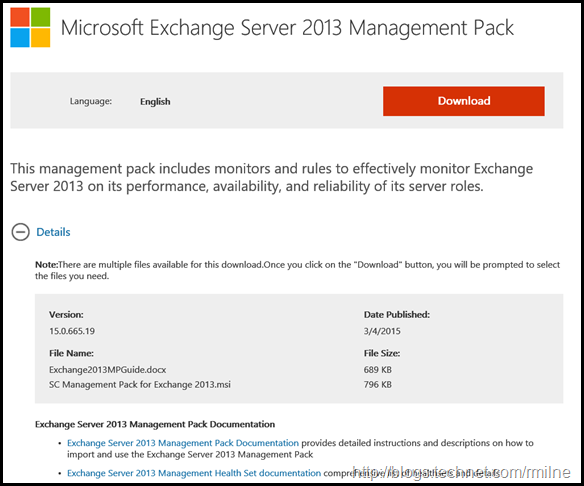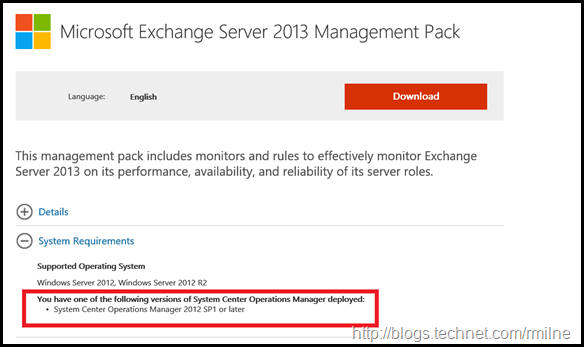The Exchange 2013 System Center Operations Manager (SCOM) Management Pack is available from the download centre.
The Exchange 2013 Management Pack is designed to work with the new features in Exchange 2013, namely Managed Availability. Previous versions of the management pack supported SCOM 2007 R2. However the newer versions of the management pack updated the system requirements to state that newer versions of SCOM are required. Please note the highlighted portion in the second image:
As of June 2015, The Management Pack (MP) is build 15.0.665.19 and can be obtained here. Before installing the MP, please be sure to review all of the documentation and prerequisites. A great starting place is the MP Guide.
Update 12-7-2013: Management Pack was updated on 12th July 2013
Update 28-10-2014: Magement Pack was updated on 28th October 2014 to version 15.0.652.19
Update 1-6-2015: Management Pack was updated on 4th March 2015 to version 15.0.665.19. Updated text to denote SCOM requirements.
Update 16-6-2016: Management Pack was updated on 28th April 2016 to version 15.0.666.20
One of great benefits of running Office 365 is that the Exchange product group can share solutions to scenarios that they see in the service which will benefit on premise installations. The Exchange Server 2013 Management Pack works with the Managed Availability feature in Exchange 2013. The alerts within the System Centre Operations Manager (SCOM) portal indicate unhealthy states as reported by the Managed Availability components in Exchange 2013.
What’s New
The following are some of the new features in the Exchange 2013 Management Pack:
- Simplified dashboard The dashboard of the Exchange 2013 Management Pack has been simplified and refined into the following three categories:
- Active Alerts Provides a list of all outstanding alerts in your organization.
- Organization Health Provides an overview of the overall service health in your organization.
- Server Health Provides an overview of the health of individual servers in your organization.
-
User focused monitoring Exchange 2013 introduces a monitoring and recovery infrastructure called Managed Availability. Managed Availability focuses on the user experience. All Exchange 2013 components have built-in monitors that detect problems and attempt to recover the service availability. Any issues that can't be recovered automatically are escalated to the Exchange 2013 Management Pack as an alert.
What’s The Big Deal With That?
What does that really mean? Well you will see a radically simpler, smaller and leaner management pack! Why is this?
Exchange 2013 with Managed Availability is now able to monitor itself and determine if it is healthy or not. Who better to gauge the condition of Exchange than Exchange itself! Another benefit is that this can be controlled by Exchange itself in two distinct ways:
-
Admins can tune Managed Availability themselves without having to engage SCOM team
-
Exchange Product Group can ship Managed Availability enhancements without having to ship a new Exchange Management Pack.
Both of these mechanisms will allow for a greater degree of flexibility and agility when monitoring Exchange 2013. Additionally you may have seen previous issues around the Exchange 2010 Management Pack when it was updated for Exchange 2010 SP2 and then re-released.
One other change that will bake people’s noodles is that changes to monitoring thresholds are to be done in Exchange directly and not in SCOM. Again this is because Exchange is monitoring itself, and SCOM is responsible for the escalations that are produced by Managed Availability.
Management Pack Troubleshooters
The Exchange Server 2013 Management Pack relies on the Managed Availability feature in Microsoft Exchange Server 2013. In Managed Availability, each component in Exchange Server 2013 monitors itself using probes, monitors, and responders. Any component that implements Managed Availability is referred to as a health set. For example the OWA Health Set has documented troubleshooting steps.
This includes getting details about the server and Health Set in question
Get-ServerHealth <server name> | ?{$_.HealthSetName -eq "<health set name>"}
Get-ServerHealth Exch-1.Tailspintoys.com | ?{$_.HealthSetName -eq "OWA"}
Check to see that none of the Alert Values are displayed as unhealthy. If one is shown in an unhealthy state, then rerun the associated monitoring probe:
Invoke-MonitoringProbe <health set name><probe name> -Server <server name> | Format-List
All of the Exchange 2013 Management Pack Troubleshooters are documented here.
Other Changes From the Exchange 2010 MP
We already covered that Exchange is now responsible for monitoring itself and SCOM will do the escalation portion of the alerting system. In addition there are a couple of other changes that are worth highlighting:
- Correlation engine – there is no correlation engine in this MP. The correlation engine was introduced in the Exchange 2010 MP to link alerts which likely had the same root cause. In large environments this could be a significant resource impact on the SCOM RMS.
- There are no additional reports included with this MP
- No additional performance monitor counters are included. Exchange 2013 does monitor a lot of performance data by default. Please look for an upcoming post on this topic!
Additional Reading
Lessons from the Datacenter: Managed Availability
Cheers,,
Rhoderick

